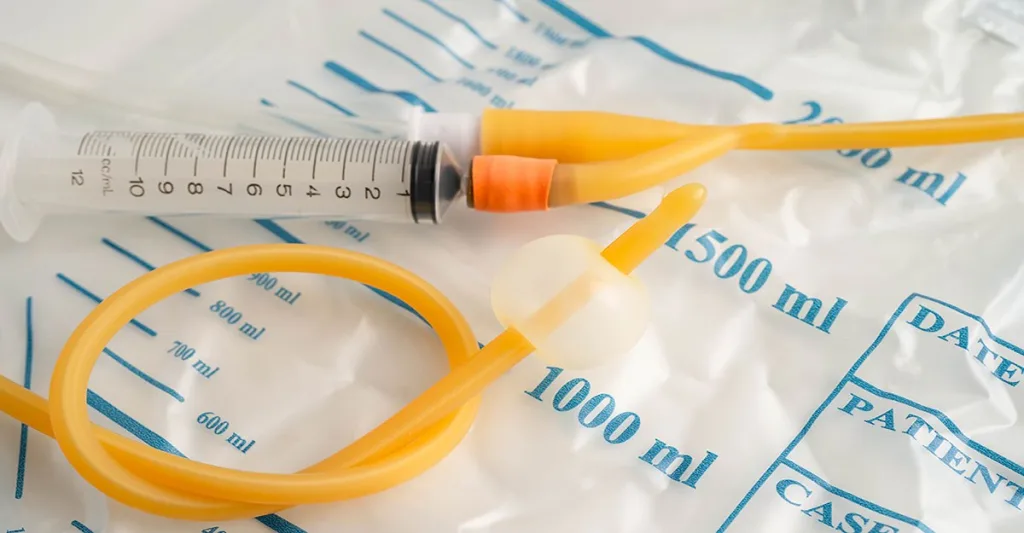As nurses, we have the incredible responsibility of providing care that not only heals but also protects our patients from potential complications during their stay in the hospital.
One of the most common and preventable complications we encounter, especially in critical care settings, is a catheter-associated urinary tract infection (CAUTI).
These infections, while sometimes brushed off as just another healthcare-associated infection (HAI), have serious consequences for patients. They can lead to extended hospital stays, higher healthcare costs, and even life-threatening complications like sepsis.
As an experienced critical care nurse, I’ve seen firsthand the impact that CAUTIs can have on a patient’s health and recovery. That’s why it’s so important that we, as nurses, do everything we can to prevent them.
Let’s start by looking at how common CAUTIs are in hospital settings.
How common are CAUTIs?
According to the U.S. Centers for Disease Control and Prevention (CDC), about 75% of all hospital-acquired urinary tract infections (UTIs) are associated with the use of indwelling urinary catheters. That means every time we place a catheter, we’re introducing the potential for infection if we’re not careful.
In critical care settings like intensive care units (ICUs), where catheters are often used for longer periods to monitor urine output or for other critical reasons, the risk is even higher. The American Association of Critical-Care Nurses (AACN) notes that in ICUs, CAUTIs are particularly common due to the prolonged use of catheters in patients who are often immobile or critically ill.
Despite efforts to reduce infection rates, a 2021 study showed that the rate of CAUTIs in ICUs was still 2.1 infections per 1,000 catheter days. While that may sound low, it’s a big deal when you consider how many patients are exposed to catheters every day.
How does a CAUTI develop?
There are several factors that can contribute to a CAUTI, and many of them are preventable. It’s not just about whether a catheter is needed — it’s also about how we place it, maintain it, and monitor it.
Prolonged use of catheters
The longer a catheter stays in place, the higher the chance of infection. Bacteria begin to colonize the catheter within 24 hours of insertion, and the risk of infection increases every day the catheter is in place. In many cases, catheters are left in longer than they need to be simply because we forget to assess whether they’re still necessary.
Improper insertion techniques
We’ve all been in those situations where the unit is short-staffed, we’re rushing, and there’s pressure to get tasks done quickly. But improper insertion techniques can introduce bacteria into the urinary tract, making it more likely for an infection to develop. A sterile technique is critical here, and any deviation from it can increase the risk of infection.
Breaks in aseptic technique during maintenance
Once a catheter is in place, it needs to stay in a closed system. This means that disconnecting the catheter from the drainage system should be avoided unless absolutely necessary. Breaks in this closed system can allow bacteria to enter the urinary tract, significantly increasing the risk of infection.
Urinary stasis
When urine is unable to drain properly, it can back up in the bladder, creating the perfect environment for bacteria to grow. This often happens when there are kinks in the catheter or the drainage bag is placed above the level of the bladder. Regular monitoring and positioning are essential to prevent urinary stasis.
Patient-related factors
Some patients are more at risk for developing CAUTIs simply because of their health status. Older adults, those with diabetes, patients with compromised immune systems, and those who are immobile or unconscious are particularly vulnerable.
Watch Nurse Alice's webinar on reducing the risk factors associated with CAUTI.
The consequences of CAUTIs
It’s easy to see CAUTIs as just another infection, but the consequences can be serious. Patients who develop CAUTIs often face a range of complications, some of which can be life-threatening.
Increased morbidity and mortality
While many CAUTIs can be treated with antibiotics, some lead to more serious complications like pyelonephritis (kidney infection) or sepsis. In critically ill patients, these infections can be particularly dangerous, increasing the risk of multi-organ failure and death.
Prolonged hospital stays
Patients who develop CAUTIs tend to stay in the hospital longer. This increases their risk of developing other complications, like pressure ulcers or deep vein thrombosis (DVT), and places an added strain on hospital resources.
Increased healthcare costs
CAUTIs are expensive to treat. A study found that a single CAUTI has an estimated cost of nearly $15,813.23 but can range anywhere between $5,700 and $25,900. When you multiply that across the healthcare system, it adds up to billions of dollars in avoidable healthcare costs each year.
Reduced patient satisfaction
Patients who develop CAUTIs often experience pain, discomfort, and a sense of helplessness. These infections can also lower a hospital’s patient satisfaction scores, which are tied to reimbursement through value-based purchasing programs. Preventing CAUTIs isn’t just about improving clinical outcomes — it’s also about improving the overall patient experience.
How nurses can prevent CAUTIs
As nurses, we’re on the front lines of CAUTI prevention. There are several evidence-based strategies that we can implement in our daily practice to reduce the risk of infection.
Use catheters only when necessary
The most effective way to prevent CAUTIs is to avoid catheterization whenever possible. Indwelling catheters should only be used when absolutely necessary, such as in cases of acute urinary retention or when accurate urine output measurement is critical. If there’s an alternative, like intermittent catheterization or the use of an external urinary device (e.g., condom catheter), advocate for it.
Integrate technology for accurate monitoring
Innovative systems can play an important role in improving catheter management, particularly by automating urine output measurements and reducing manual interventions. Systems such as Accuryn use technologies like their patented active drain line clearance, which allows for continuous and accurate monitoring of urine output. This helps to minimize the risk of inaccurate readings.
Additionally, these systems are often designed to prevent backflow into the bladder, which is a key factor in reducing the risk of catheter-associated urinary tract infections (CAUTIs).
By integrating such advanced technologies into catheter care protocols, nurses can enhance the management process, ensuring catheters are used only when necessary and improving overall patient safety.
Practice sterile insertion techniques
Maintaining sterile technique during catheter insertion is critical. This involves proper hand hygiene, the use of sterile gloves and equipment, and thoroughly cleaning the patient's perineal area before insertion. Taking an extra minute to ensure sterility during insertion can prevent a lot of harm down the road.
Perform daily catheter assessments
Assessing whether a catheter is still necessary should be a part of every shift assessment. Studies have shown that daily reminders or automatic stop orders for catheter removal can significantly reduce CAUTI rates. If a catheter is no longer needed, it should be removed as soon as possible. Innovations such as Accuryn aid in this process by providing accurate, real-time data, clinicians can review to make informed decisions around catheter removal.
Maintain a closed drainage system
Once a catheter is in place, maintain a closed drainage system to prevent CAUTIs. Avoid disconnecting the catheter from the drainage bag unless absolutely necessary and make sure the drainage bag is always placed below bladder level to prevent urine from flowing back into the bladder.
Ensure proper perineal care
Patients with indwelling catheters should receive regular perineal care to reduce the risk of infection. This includes cleaning the catheter insertion site with soap and water at least once a day and after bowel movements.
Nurse-led CAUTI prevention protocols
Many hospitals have implemented nurse-led CAUTI prevention protocols, which have been shown to significantly reduce infection rates. These protocols typically include daily catheter assessments, proper insertion techniques, and technology integration enhancing the nurse’s ability to make informed decisions about catheter use and patient care.
Bringing it all together
Catheter-associated urinary tract infections are preventable, and as nurses, we are the key to preventing them. By adhering to evidence-based practices — such as appropriate catheter use, sterile insertion techniques, daily assessments, and proper catheter care — we can reduce the risk of CAUTIs and improve patient outcomes.
But preventing CAUTIs isn’t just about following protocols; it’s about advocating for our patients, ensuring their safety, and providing the best care possible. Every step we take toward prevention makes a difference.
Connect with "Nurse Alice"
I hope you found this information helpful. Do you have any questions or comments? Let’s connect! I’m passionate about mentoring, teaching, and helping fellow nurses. Join me in the Nurse.com Community so you can stay updated on upcoming events and the latest articles.
And catch my latest Ask Nurse Alice podcast episodes. Let's keep learning and growing together!









